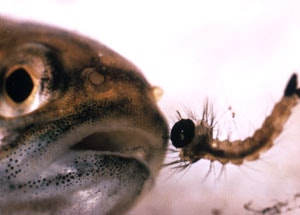Biological Controls

Biological Controls are the implementation of natural predators of mosquitoes to help reduce overall populations. Unfortunately there are not many natural predators available that appear to work in mosquito control. Animals such as bats and small birds, like purple Martins, are believed to eat large amounts of mosquitoes, but studies indicate that mosquitoes make up a very small portion, or even no portion, of their diets. Dragonflies appear to help in reducing numbers, but problems exist with using dragonflies as a control measure; their effectiveness has not been thoroughly studied, they have limited environments where they can survive, and rearing and distributing dragonfly populations is difficult and expensive.
Mosquitofish, or Gambusia, are small, darkly colored, guppy-looking fish. They have voracious appetites for the larvae of mosquitoes. In certain areas they seem to be quite effective, but they are not 100% reliable and water sites where introduction is allowed are limited. Gambusia have shown to be quite effective for watering troughs and decorative ponds. Benton County MCD has a permission to transport the fish (for the purpose of larval mosquito control) by the Washington Department of Fish and Wildlife.
